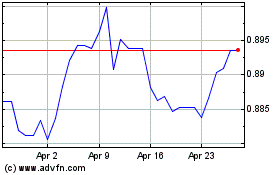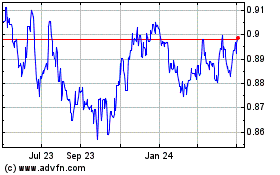Australian Dollar Falls As Weak Economic Data Spur Rate Cut Speculation
January 30 2024 - 8:53PM
RTTF2
The Australian dollar weakened against other major currencies in
the Asian session on Wednesday, as the weaker inflation data from
Australian economy fueled bets on rate cuts from the Reserve Bank
of Australia in 2024.
Data from the Australian Bureau of Statistics showed that the
consumer prices in Australia were up 4.1 percent on year on year in
the fourth quarter of 2023. That was shy of expectations for an
increase of 4.3 percent and down from 5.4 percent in the previous
three month.
On a seasonally adjusted quarterly basis, inflation rose 0.6
percent, again missing forecasts for 0.8 percent and down from 1.2
percent in the three months prior.
Data from the National Bureau of Statistics showed that the
manufacturing sector in China continued to contract in January,
albeit at a slower pace, with a manufacturing PMI score of 49.2.
That's up from 49.0 in December, although it remains beneath the
boom-or-bust line of 50 that separates expansion from
contraction.
The non-manufacturing index improved to 50.7 in January, the NBS
said - up from 50.4 in the previous month.
The Asian stock markets also traded lower, as traders became
cautious and look ahead to the U.S. Fed's interest rate decision
later in the day. The Fed is widely expected to leave interest
rates unchanged, but the accompanying statement could have a
significant impact on the outlook for interest rates. They also
react to a slew of economic data from the U.S., China, Australia
and Japan.
In other economic news, data from the Reserve Bank of Australia
showed that the total private sector credit in Australia was up 0.4
percent on month in December, unchanged from the November reading.
On a yearly basis, private sector credit gained 4.8 percent.
In the Asian trading today, the Australian dollar fell to nearly
a 2-week low of 96.83 against the yen, from yesterday's closing
value of 97.43. The aussie may test support near the 95.00
region.
In economic news, industrial production in Japan was up a
seasonally adjusted 1.8 percent on month in December, the Ministry
of Economy, Trade and Industry said in Wednesday's preliminary
report. That missed expectations for an increase of 2.4 percent
after slipping 0.9 percent in November. On a yearly basis,
industrial production was down 0.7 percent.
Against the U.S. dollar and the euro, the aussie dropped to an
8-day low of 0.6559 and a 2-day low of 1.6500 from Tuesday's
closing quotes of 0.6601 and 1.6423, respectively. If the aussie
extends its downtrend, it is likely to find support around 0.63
against the greenback and 1.67 against the euro.
Against the Canada and the New Zealand dollars, the aussie
slipped to more than 2-week lows of 0.8801 and 1.0727 from
yesterday's closing quotes of 0.8843 and 1.0756, respectively. The
next possible upside target for the aussie is seen around 0.87
against the loonie and 1.06 against the kiwi.
Looking ahead, Germany's unemployment data, flash consumer and
harmonized consumer price data, all for January, are due to be
released in the European session.
In the New York session, U.S. MBA mortgage approvals data,
German CPI data for January, U.S. jobs data for January, Canada GDP
data for December, U.S. Chicago PMI for January and U.S. EIA crude
oil data are set to be published.
At 2:00 pm ET, the U.S. Federal Reserve will conclude its
two-day monetary policy. The central bank is widely expected to
leave the federal funds rate unchanged.
AUD vs CAD (FX:AUDCAD)
Forex Chart
From Jun 2024 to Jul 2024

AUD vs CAD (FX:AUDCAD)
Forex Chart
From Jul 2023 to Jul 2024
